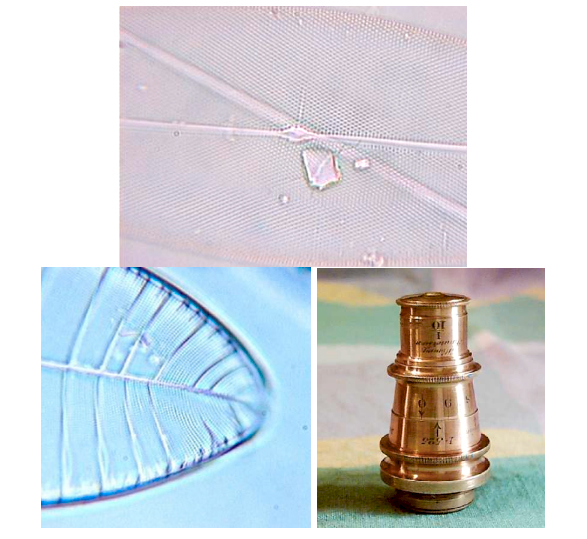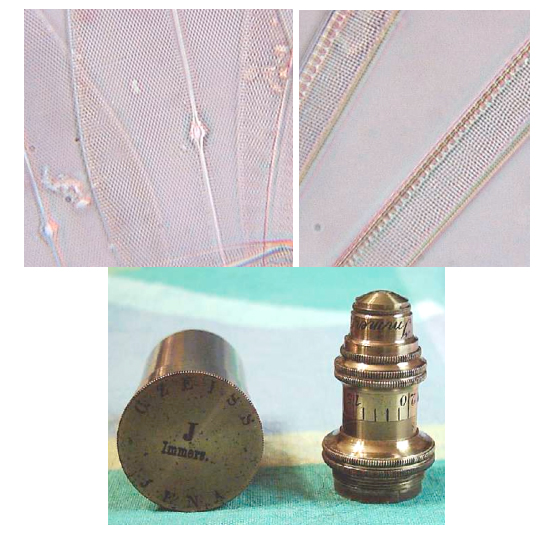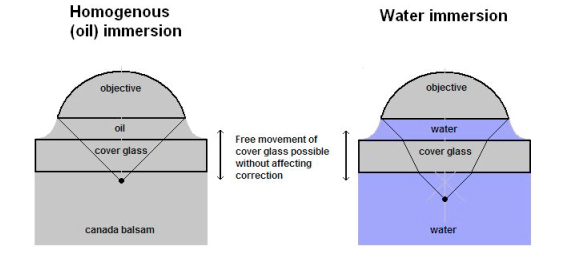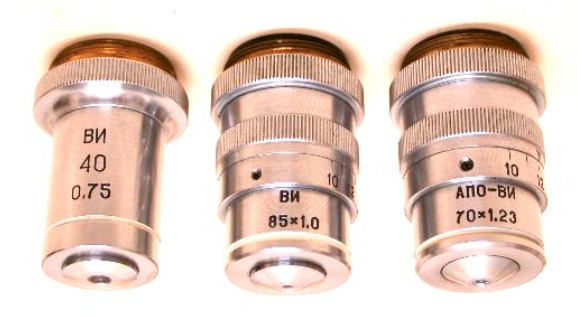
|
Part 1: Introduction by René van Wezel, UK |
Compared to the average 100x oil immersion lens on most microscopes, a water immersion lens is a joy to use. The cumbersome cleaning of the slide and lens makes the oil immersion objective generally the last (and least) used lens. And don't even think about a quick change to lower magnification to find that other interesting part back in the slide...
With a water immersion lens however, simply suck the water away with a sliver of filter paper. Remnants of water evaporate quickly and within a couple of seconds you can go back to a lower magnification. It even works on water mounted slides, which after use with an oil immersion only serves the cleaning jar.
Water versus oil immersion
Unfortunately, despite their easiness of use, water immersion lenses have not generally been very popular. The oil immersion lens sold by default with every set of objectives makes sure that a water immersion objective is either not known, or seen as superfluous, and generally regarded 'not as good' anyway.
There is a point of truth in there, as an oil immersion lens can achieve a higher aperture, and therefore a higher resolution compared to a water immersion lens. This shows by oil immersion lenses having a higher numerical aperture (NA) of around 1.25-1.4, which for water immersions is maximally 1.25 (btw, a difference of circa 10% resolution wise only).
Also from another point of view, the oil or homogenous immersion (HI) seems ideal. With similar refraction indices of glass, oil and mounting medium, the illumination cone passes without any deviation straight into the objective lens.
With a water immersion lens however, refraction of the rays occurs on the glass - water boundaries. The lens has to be corrected for these slight deviations, and one obvious problem here is that the thickness of the cover glass influences the amount of correction needed. This is particularly the case with high power water immersion lenses, and these generally have a correction collar with which the cover glass thickness can be set between 0.10 and 0.20 mm.

Figure 1: Schematic ray patterns of an oil immersion versus a water immersion objective, designed for use with cover glasses. Because of the difference in refractive index in the light path, a water immersion objective needs correction, the amount of which is dependent on the thickness of the cover glass. When a resin mount is used with a water immersion objective, the depth of the specimen in the mountant has to be added to the thickness of the cover glass.
Of course, for a homogenous (oil) immersion, there is no light deviation, so these lenses are naturally not sensitive to thickness variation of the cover glass. They can be used just as well without cover glass, for example on dried blood or bacteria slides.
This is clearly not possible with a high aperture water immersion lens: when the objective is designed for use with a cover glass, the image becomes fuzzy when the cover glass is omitted. This is caused by spherical aberration, and this occurs also with non-immersion lenses: an ordinary 40/0.65 dry lens for example does not give a good picture without cover glass, unless specifically designed to be used this way (like for microscopes that are in use in the semi-conductor industry and metallurgy).
Compared to dry lenses, water immersions are naturally less sensitive for this optical aberration, because the difference from glass to water is smaller then from glass to air (with a dry lens). Therefore, the need for a correction collar on a water immersion lens arises at the somewhat higher NA of around 0.9. So a typical medium power water immersion lens like the LOMO 40/0.75 WI lens can be used successfully with or without cover glass, whereas a normal (dry) 40x lens will show clear image degradation.
The development of the immersion type of objectives was actually mostly concerned with the construction of water immersion lenses, starting from around 1850. See for an interesting summary on this matter:
http://www.smecc.org/history_of_oil_immersion_lenses.htm by James Solliday.
The first immersion objectives in
production weren't as good as the best dry lenses in those
days, but some workers were convinced higher resolution could
be gained by immersion. This actually started quite a nasty
discussion between a couple of prominent microscopists at the
time, which was eventually settled in the 1870's when a lens
made by Tolles was clearly superior with the substantially
higher NA of 1.2 compared to the maximum (theoretical) NA of
1.0 for a dry lens
(see
http://www.smecc.org/the_aperture_wars.htm
by James Solliday).

Figures 2-4: Already by 1870, prime examples of optical wizardry were produced. These pictures were made with a 1/10th immersion lens, made around 1875 by Robert J. Tolles and which has correction settings for immersion with water through to cedarwood oil. Pleurosigma angulatum (left) and Surirella gemma (right), two well known test diatoms for microscopy. Images courtesy of Mervyn Hobden.

Figures 5-7: A Zeiss 'J' achromat water immersion lens of circa 1880 is also able to give images that are surprisingly good compared to modern equivalent lenses. This objective contains a correction collar for difference in cover glass thickness. Pleurosigma angulatum (left) and Nitzschia sigma (right). Images courtesy of Mervyn Hobden.
Newfound popularity of water immersions
Around 1900, there was a substantial array of water immersion lenses available, but throughout the 20th century supply dwindled to quite low numbers. However, a renewed interest in water immersion objectives has been steadily growing in the professional field since the 1990's.
With a focus in the Life Sciences nowadays on in vivo examination, it was readily realised that the unavoidable water (saline) mounting method for fresh biological specimens gave rise to serious problems. Compared to resins like canada balsam, which has similar optical properties to glass and immersion oil, a water mounted specimen is not ideal for an oil immersion objective.
A water layer of only 0.05 mm between
specimen and cover glass degrades the resolution of a 60/1.4
oil immersion lens by over 50%, and severely lowers contrast.
In contrast, a 60/1.2 water immersion maintains its
performance perfectly well over at least as much as 0.15 mm
water (data from Nikon at
http://microscopyu.com/articles/optics/waterimmersionobjectives.html).

Figure 8: Homogenous (oil) and water immersion. Within the boundaries set by distance of lens to specimen, the cover glass can move up and down (or the lens can be focussed deeper into the specimen) without affecting image quality. This is only possible when the immersion medium is similar to the mounting medium.
Just because of the insensitivity of the water immersion lenses to the mounting thickness, these lenses can peer deep into the specimen with great clarity and accuracy.
An oil immersion objective could do this also when applied with a correction collar that would have to be set for each depth (which is highly impractical, but they are indeed being produced for specialised applications). However, in the conditions used here, there is no gain to be had at all as the limiting factor in this system is still the water-glass boundary (specimen to cover glass), and this limits the NA theoretically to 1.33 (ie the refraction index of water) and practically to around 1.25.
The advantages of the water immersion objectives for in vivo work are well understood, and the modern and hugely expensive confocal laser scanning microscope systems for the life sciences nowadays are often fitted as a standard with water immersion objectives. Unfortunately, for these modern applications the demands on these lenses are very high, and the resulting price tag for a single lens can easily mount up to 10x the amount of money that an amateur wants to spend on an entire microscope.
Luckily, there are alternative sources for water immersion lenses. Best known is the Russian manufacturer LOMO, who still produces a series of water immersion lenses.

Figure 9: A series of more recent Lomo water immersion lenses: two achromats 40/0.75 and 85/1.0 and an apochromat 70/1.23, the latter two containing a correction collar for variation in cover glass thickness. The 40x and 70x lenses are Zeiss designs from the 1890's (!)
References and acknowledgments
Many thanks to Mervyn Hobden for his friendly permission to use images that he has made with the vintage Tolles and Zeiss objectives.
Paul James has written an excellent article on water immersion articles earlier in Micscape:
http://www.microscopy-uk.org.uk/mag/artoct04/pjwater.html
A good oversight of the ins and outs of immersion is given on http://microscopy.fsu.edu/primer/anatomy/immersion.html
An overview of modern uses of water immersion objectives can be found on http://microscopyu.com/articles/optics/waterimmersionobjectives.html
http://www.smecc.org/history_of_oil_immersion_lenses.htm and http://www.smecc.org/the_aperture_wars.htm are based on a discussion on the Yahoo Microscope group during February 2004. These magnificent pieces of research in historical microscopy by James Solliday originally started with a discussion about the (im)possibility of seeing very fine diatom details with objective lenses that theoretically do not permit seeing these details. An extraction of messages, also containing a treatise on the life of Robert J. Tolles can be found here: History of immersion lenses.
All comments to the author Rene van Wezel are welcomed.
Please report any Web problems or offer general comments to the Micscape Editor.
Micscape is the on-line monthly magazine of the Microscopy UK web site at Microscopy-UK
© Onview.net Ltd, Microscopy-UK, and all contributors 1995 onwards. All rights reserved. Main site is at www.microscopy-uk.org.uk with full mirror at www.microscopy-uk.net .